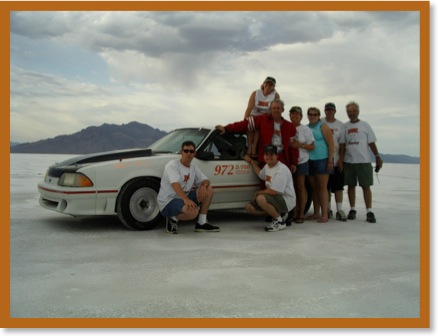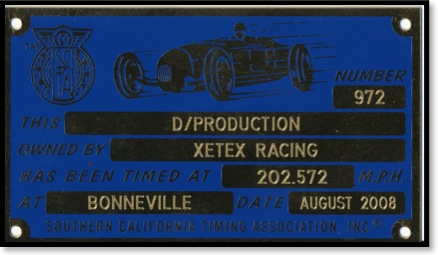We started racing at Bonneville in 2004. Speed week is held in the middle of August every year; I'm told it sometimes gets hot there!

Our first car was a
1987 Ford Mustang GT that I bought new to drive to work.
After some 180,000 miles, it was time to find a new purpose
for it. After thinking about it for a while, I decided to
see if we could push this aerodynamic disaster over 200 mph
using a 5.0 engine. On gas, without nitrous or a blower.
The computer said, "maybe”…
The first engine was basically a street motor with aluminum
heads, a Comp Cams hydraulic roller, and a Victor Jr.
intake running a custom Holley carburetor. This was enough
for all of us to make a pass over 140 mph and I got one run
at 169! Unfortunately, we had fuel pump issues, the engine
went lean, and it ended up swallowing the #5 exhaust valve.
We rebounded in 2005 with an engine that was similar to
2004, another street motor setup about the same way. Ate
another valve at the Texas Mile to start the year. Brand
new engine, no less. Pulled an engine out of Martha's deuce
and moved some of the goodies to it. Speed week went pretty
well -- at least until the rains came. A few more of us got
some licensing passes.
For 2006, we had a real race engine built by Greg Grossett
at Total Performance in Santee, CA. First run was an easy
pass to check things out -- and I qualified for the long
course by running over 175 from the 2 to 2.25 mile markers!
Shifted over to the long course to see what she would do.
Ran out of oil pressure just past the 3 mile, however, and
had to shut down. With a number of changes, I finally
managed to keep power on to the 4 mile marker, netting
195.002 mph. The kids ran a car I had bought from JBA -- a
2000 Ford Focus with a souped-up 2.0L DOHC engine. We never
got going very well and ended up throwing a rod through the
block. Justin Baas was driving but we don't blame him for
the engine. I think it had spun a rod bearing before we
even bought it and this was the last straw for that engine.
2007 was to be the year I finally went 200+ mph. Ahhh,
wouldn't that have been nice. We had a nice trip to
Bonneville and back, but not much fun while we were there.
On the other hand, it was remarkable that we got to run at
all. The crew that sets up the course managed to rescue the
meet after rain threatened to cancel the whole thing. We
cannot believe what wonders these folks accomplished to
present us with two long courses to run on. Just wish we
could have made more than one run ...
2008
was when I finally reached my goal -- 202.572 in the last
mile!

Exit speed was 202.908 so that was all she had! There ain't
no more.
The kids got a new engine in the Focus for 2008 but had
nothing but trouble on the salt. We took it home to work on
for 2009.
In 2009 we only took the Focus to Bonneville with the idea
of focussing (sorry) on getting it to run on the record. We
worked and worked but couldn't overcome a carburetor issue
-- the air/fuel ratio kept increasing as the car went down
the course. It would start off pig-rich in 1st gear at
maybe 10:1, get better in the intermediate gears, and end
up at maybe 14 or 15:1 in 6th. Way too lean. In fact, we
finally lost compression in a couple of cylinders and quit.
Best guess is that the fuel in the float chamber was
frothing and the extra air caused it to go lean. The
anti-vibration o-ring carburetor mounts didn't work as
advertised.
We are looking at going back to fuel injection. The engine
needs to come out and get some TLC, as well. The plan is to
try very hard in 2011. The engine is being rebuilt (no
sleeves needed yet!). I sent the head back to Greg Grosset
at Total Performance to be rebuilt. They replaced the
valves with slightly larger ones (suitable for later
turbocharging), new seats, improved the porting a little,
and sent it back to me. I almost immediately sent it back
to California to Hogan's for a custom FI intake. The engine
should be ready very soon, then off to Henderson
Performance in New Braunfels for Corey to plumb up the fuel
injection and tune the engine on his dyno. If this isn't
serious, I don't know what is.
Jim Best and I took the Mustang back to Bonneville in 2010.
Didn't do much good -- best speed was 196 -- but we made 15
runs and had a lot of fun. Someone at the salt pointed out
that getting a dozen or so passes over 180-190 mph is
really not such a bad thing. I guess I have to agree. Then
a photographer from Bonneville sent me some pictures of the
car he took at the 2 mile mark (see the 2010 page). The
hood was flapping up and down and the front fascia was
bending in. This is about the place where the datalogger
said the AFR was spiking up from 12.5 to 14 or 15 briefly.
Hmmm. Jim and I took a look and decided that we could brace
the front fascia and clamp the hood a bit better and, while
we're at it, build the carb airbox and scoop I had wanted
to do last year and, what the heck, let's take her back in
2011.
Meanwhile, Russ Eyres had been building the chassis for a
lakester for me. I "designed" it over 2009-10 and we went
over those sketches early in 2010. Russ started bending
metal after Speed Week 2010. Needless to say, a lot had to
change from my original 'design' to make it actually work
but, by and large, the shape and dimensions are as I wanted
them. I went out and picked up the rolling chassis in April
of 2011 and it's now in my hangar. The plan was that Jim
and I would finish the car -- plumbing, wiring, body, etc.
-- and maybe have it ready in 2012. We were discussing the
pros and cons of fibreglas vrs aluminum for the body,
keeping in mind our limited skill set.
Those plans took a big hit on October 27th, 2010, when
Jim's plane crashed just off our airstrip and he was
killed. I'm working on the lakester now but it just isn't
the same and the Mustang is finished as a LSR car. RIP Jim.
I did get the lakester running. Took it out to SoCal in
spring of 2012 to get a pre-inspection from Steve Davies.
Russ and I fixed the couple of things Steve found lacking
and then we took the car up to El Mirage for an afternoon
of 'private time' and then for the May El Mirage meet. Had
some teething issues and never got going very fast (165 or
so) but the main thing was going through Tech Inspection in
preparation for Speed Week that summer. The car was
completely body-free -- just tube hoops and wind blowing up
my pants legs. Exciting...and cool!
Speed Week 2012 saw the lakester on the salt for the first
time. Still had issues with the shifter mechanism. It was a
good idea that wasn't working! Never did get it to shift
into all four gears but, eventually, I got the car
qualified for the long course and finally got it over 200
mph. But it was a grind. Had to do it, however, because we
were going to spread Jim's ashes on the salt and I promised
him a ride at over 200. Had to do it, and I did.
Jim's daughters were there for the occasion. Turns out they
liked it. Started pestering me about running another car.
So I let them campaign the Focus, figuring this would be a
safe and reasonable place to start. They had their share of
problems getting ready but, up on the salt, they made it go
faster than we had ever gotten it to go! And, when it was
done, they wanted to go faster. Imagine that! The lakester
had a body on it for 2013, which I confidently expected
would raise my speeds up significantly. Umm ... not so
much. Max exit speed of 214 wasn't much higher than before.
But there was terrible buffeting going on inside the cage
and I suspect the engine was getting pretty dirty air as
well. Thinking about it, I decided to try installing a
simple windscreen and an engine scoop.
For 2014, I offered the girls the old Mustang to run. I had
most of an engine laying around. Block and crank, a set of
higher-compression pistons (one had to be replaced) with
rods, Victor Jr. heads and intake, custom 750 Holley, MSD
distributor, flywheel, scattershield, toploader 4-speed,
headers and collectors. They had the engine assembled by
Rick Pridgen at Parks Engine Service, here in Seguin (he
has assembled all of my engines over the past 6-7 years).
Rick ordered up a Bullet solid roller cam and threw in some
roller rockers and misc. parts. Ended up with an engine
that the computer guessed would put out about 480 hp at
7200 rpm. Better than any of the engines I originally built
for the Mustang. They took it to the Texas Mile in March,
2014 and did a best speed of 163. The computer predicted
165, based on the computer model for the engine. Pretty
close. Same computer predicted 180+ at Bonneville.
They hauled the car up to Wendover, arriving just after the
deluge hit, covering the salt flats with up to a foot of
water. We all sat around for several days until the
SCTA/BNI officials came to the (reluctant) conclusion that
the water was not going away and they cancelled the meet.
USFRA managed to put on a meet the next month but the World
Finals had to be cancelled in October because of standing
water. Bummer! Just wait until next year, they said.
Come 2015 and Bonneville was rained out again! Or,
technically, mudded out. The shrinkage of the salt flats
(BLM has yet to admit this has happened) finally resulted
in the salt flats being lower than the surrounding mud
flats. An energetic spring rain deposited a layer of mud on
the salt. Normal processes led to a thin skim of salt atop
the mud that looked like the old salt flats but was too
thin to support much traffic, much less any course
preparation. It is far from clear that there will
ever
be another Speed Week.
I remain hopeful but have decided to concentrate on El
Mirage for the short term, just in case.



